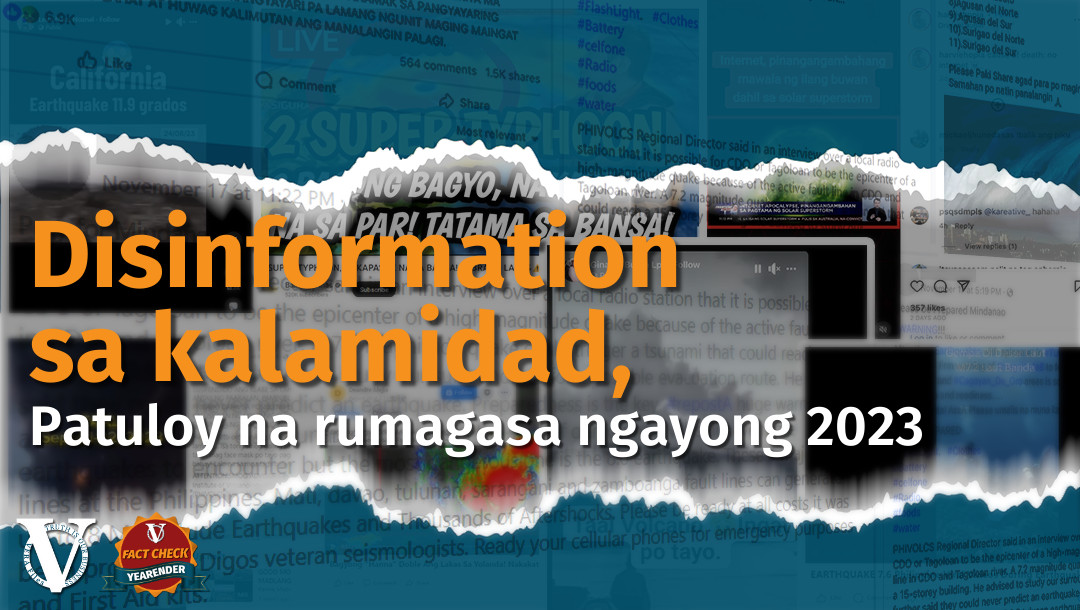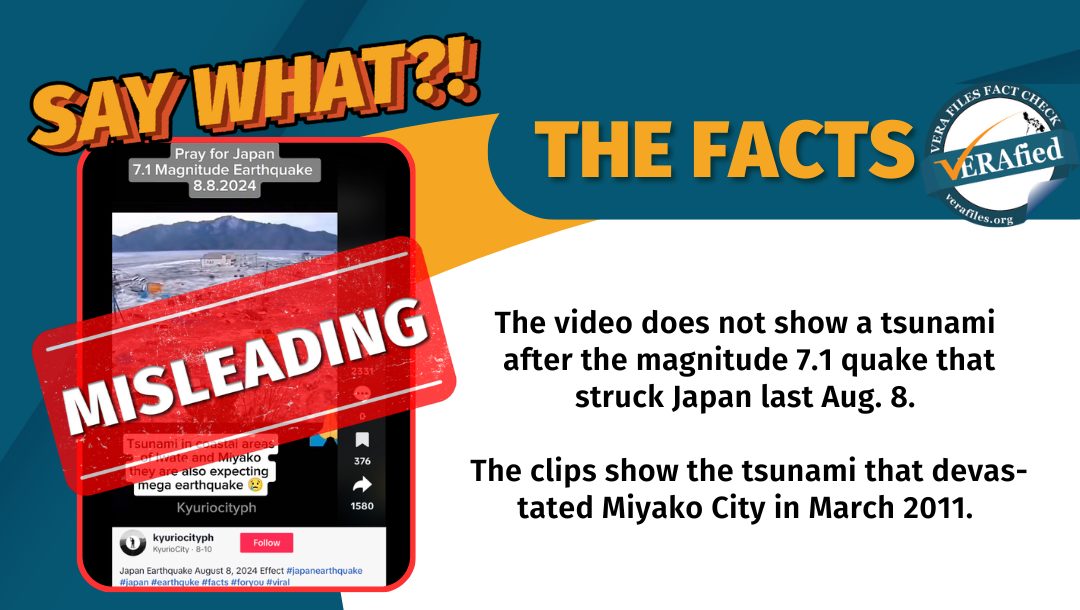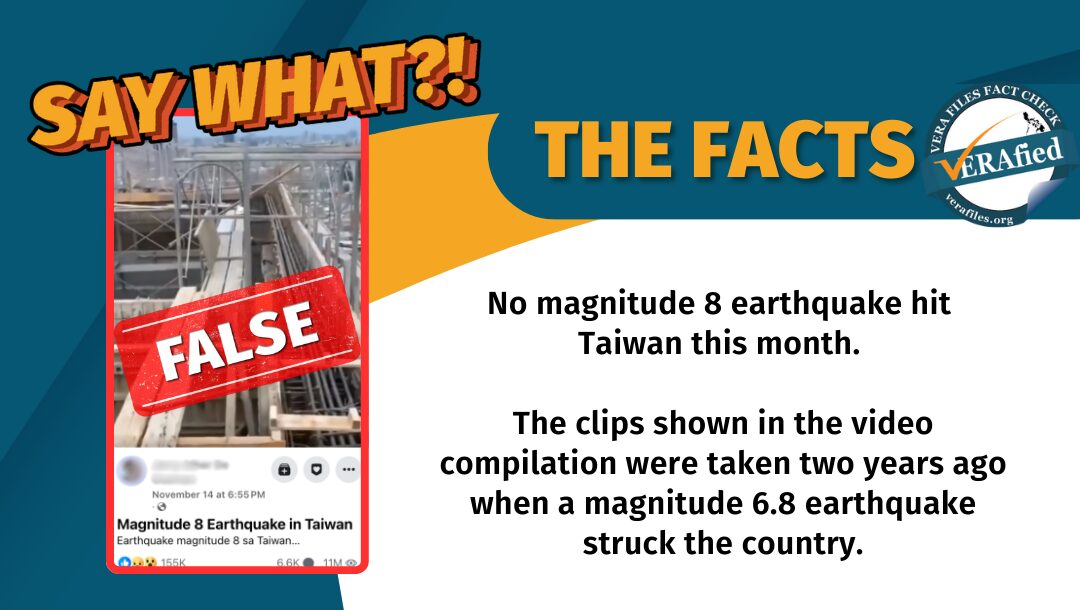The typhoon season in the Philippines from July to September not only brought disaster in the form of casualties, agricultural and economic damage and interruptions at schools and work. It also led to typhoon-related misinformation online.
Among these were exaggerations about the number and strength of typhoons hitting the country this year, warnings about super typhoons that did not actually exist and false typhoon advisories used as clickbait for online shopping ads.
VERA Files Fact Check, in partnership with Meta’s Third-Party Fact-Checking Program, published 386 fact checks from Jan. 1 to Dec. 9. Of these, eight fact-check articles debunked misinformation related to typhoons.
Five of these stories addressed claims that either contradicted or embellished actual typhoon updates from the Philippine Atmospheric, Geophysical and Astronomical Services Administration (PAGASA).
Ariel Rojas, ABS-CBN’s resident meteorologist, said spreading misinformation during typhoon season may cause disaster fatigue and make the public indifferent about actual threats.
“So, pag may actual na bagyo, hindi na sila nagpre-prepare,” Rojas said in a Dec. 9 interview. “Nagkakaroon ng complacency or napapagod ‘yung tao.”
(So, if there’s an actual typhoon, they do not prepare. The public becomes complacent or tired.)
Meanwhile, Samuel Cabbuag, an assistant professor of sociology at the University of the Philippines Diliman, said some content created on social media, especially on TikTok, would look like “something that wants to go viral.”
“‘Yung ibang mga creators, they would create content na medyo extreme ‘yung tone. ‘[Bagyong] Mas malaki sa … buong Pilipinas,’ Siyempre, ‘pag ikaw nakita mo ‘yun, magugulat ka rin, ‘di ba,” he said in a Dec. 6 interview.
(Other creators would create content with an extreme tone. ‘[A typhoon] that’s bigger than the entire Philippines.’ Of course, if you see that, you would be surprised, right?)
A claim debunked by VERA Files Fact Check falsely stated in September that a super typhoon will hit the country. The two posts on TikTok and one on Facebook that carried this erroneous claim garnered a total of 1.68 million views and 48,611 reactions.
Another post falsely claimed that 25 tropical cyclones would affect the country in 2024. We found out in October that the list only enumerates names to be assigned to typhoons should they enter the Philippine Area of Responsibility.
Anxiety drives people to share information about typhoons and natural disasters, according to Jose Mari Lanuza, an assistant professor at the University of the Philippines Manila’s Department of Political Science.
He said if the demand for information is high and people are anxiously waiting for information from the government, “if they see information even if it’s not from PAGASA, they’ll likely click on it.”
For instance, a netizen would warn others by sharing a video of a typhoon seen on FB, even if it actually shows a typhoon from another country, Lanuza said.
Rojas noted that netizens have a tendency to share information based on their emotions, thinking that everything they see online is true.
In some cases, they would share made-up reports about fictitious typhoons without knowing those were actually fake.
‘Weather,’ ‘news’ FB pages biggest typhoon misinfo sources
VERA Files Fact Check tracked 24 sources that published typhoon-related misinformation. Twelve of them (50%) or half came from various FB pages.
Five had the phrase “Philippine Weather” or “Weather Update” in their name, three had the phrase “Metro Headlines,” two posed as “breaking news” channels and two others posted memes.
FB pages with “Metro Headlines” on their name posted a mix of trending stories, clickbait content that redirects to other affiliate links and showbiz news.
One FB page named Breaking News (created on June 20) mainly reposted content from pro-Duterte vlogger Even Demata, while another FB page named Buknoy News Channel (created on Jan. 24) posted breaking news and weather updates.
Two other FB pages, named Kurdapyo (created on Aug. 6, 2022) and DREAM B (created on Jan. 31), mainly posted quotes in Bisaya and videos of other people, respectively.
Of the 24 sources, eight were ordinary citizens who labeled themselves as “digital creators,” with followers ranging from 5,000 to 175,000 people. Three others were from TikTok and one is a now-defunct YouTube channel.
Seeking accountability from tech platforms
Rojas is frustrated with social media platforms like FB and YouTube, which, he said, do not provide adequate means for netizens to report typhoon-related misinformation, thus discouraging the public from taking action.
“‘Yun ‘yung nakakapagod at nakakalungkot na part kasi instead na matutulungan ka ng mismong platform kung saan kumakalat ‘yung misleading [posts] at disinformation, hindi ka matutulungan at all,” he said.
(That’s the exhausting and disappointing part because instead of getting help from the social media platform where misleading posts and disinformation spread, you won’t get any help at all.)
Lanuza, on the other hand, called out social media platforms like FB for not nipping disinformation narratives in the bud, instead passing the burden of information quality control to info suppliers and consumers.
At present, Meta partners with third-party fact checkers like VERA Files to help fight misinformation on its platforms. Fact checkers identify false and misleading posts and publish fact checks. Corresponding fact-check ratings appear on the posts, as well as a link to the article for more information.
Certain content and pages that repeatedly share false information also become less visible on FB and Instagram. These measures, however, do not prevent people from accessing content that was fact-checked.
Too few fact checkers, too many typhoon-related disinfo
There’s too much typhoon-related misinformation and too few experts to combat its spread online, according to Rojas, who used to work as a PAGASA weather specialist.
“Mahina ‘yung lumalaban sa sobrang dami ng kailangang labanan. So, hindi siya evenly matched,” he said. (The people who counter [typhoon-related misinformation] are weak because there are so many [claims] that need to be addressed. So, it’s not evenly matched.)
He cited occasions when people asked him to clarify typhoon-related misinformation during typhoons, but since he was too busy with work, his replies came too late.
Learning from this, he now live streams videos on ABS-CBN’s news channel to warn people against erroneous typhoon alerts. Sometimes, his videos reach a peak of 30,000 live stream viewers.
“But, it’s not enough,” he admitted, citing the case of an erroneous post shared almost 1,000 times on Facebook, reaching a lot of people before it was fact-checked.
Rojas was referring to a post he saw on Dec. 9, falsely claiming that typhoons Romina and Querubin would hit the Philippines this December. He said it was not true because PAGASA has not yet monitored any typhoons.
How can netizens avoid sharing typhoon-related misinformation?
Netizens should avoid reacting to typhoon-related posts that make them nervous and scared, Rojas advised. On FB, a user can also press the X button to hide similar posts, he added.
Avoid commenting or sharing such posts because any engagement would make those more viral, he added.
Rojas also urged netizens to follow the official pages of PAGASA, mainstream media organizations, or weather experts like him on FB.
Filipinos must be taught media literacy from an early age so they can swim through social media platforms filled with mis- and disinformation, Rojas added.
“Kasi otherwise… malulunod ka doon sa misinformation, disinformation. Hindi mo alam na lahat na nakikita mo pala sa iyong feed ay puro fake news. Weather news man ‘yan o iba pang balita,” he said.
(Because otherwise… you’ll drown in misinformation and disinformation, you don’t know that everything that you see in your feed is all fake news. Whether it’s weather news or other news.)







